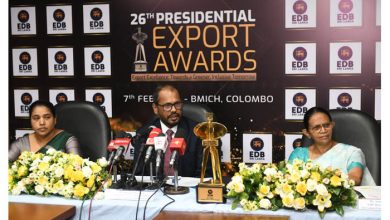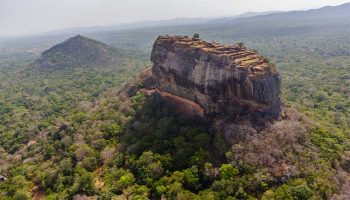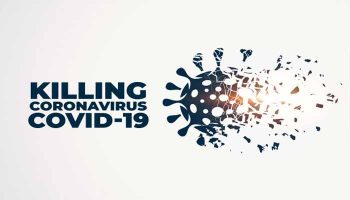Angampora
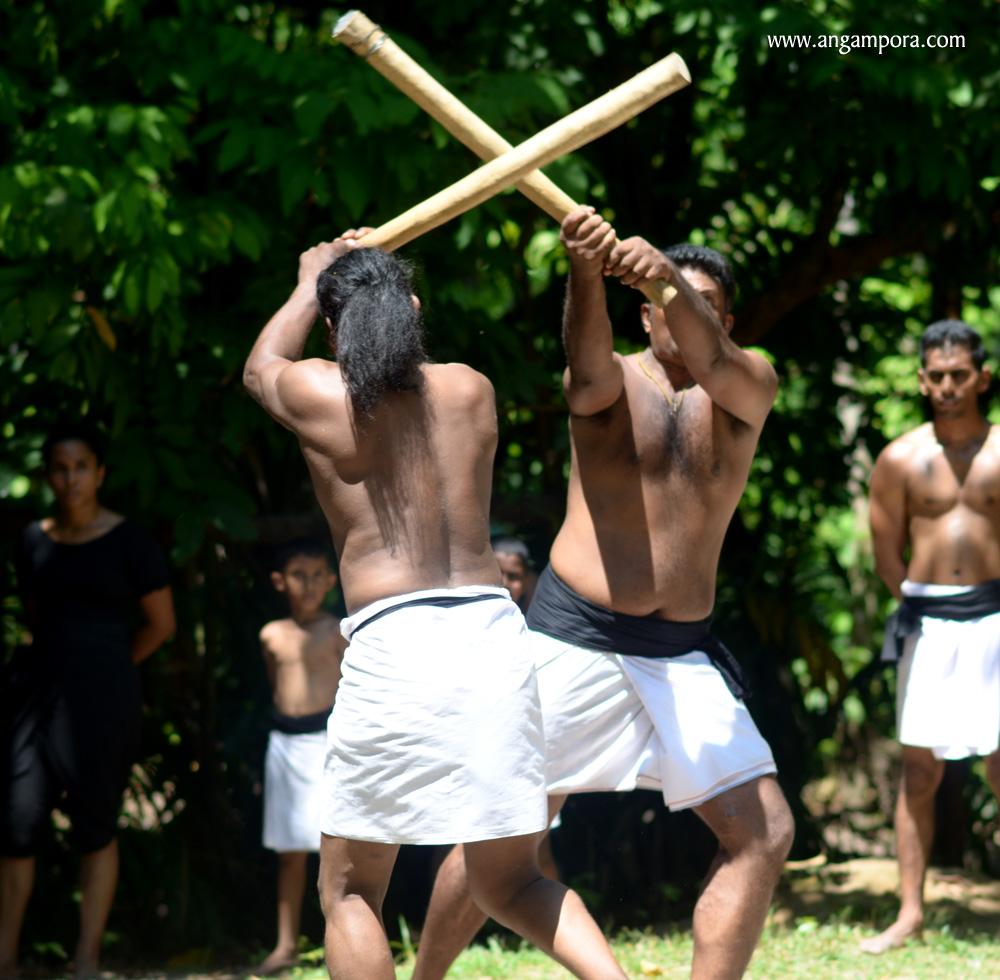
Angampora is one of the unique features that has been embellished into the history, culture and heritage of Sri Lanka. This ancient martial art is not mearely an art of combat. It is a refined philosophy that embraces the forces of nature and cosmic energies and has done so for thousands of years.
Sri Lankan Traditional Indigenous Martial Art Association(STIMA) which comprises gurus and students from various Angam clans is the main organization which is responsible in sharing knowledge and the preservation of this art by researching, categorizing, organizing and storing knowledge in one place to be carried forward for the future generation.
Here STIMA describes in detail the history and main features of Angam martial art form.
There exists a small island which is little known in this world… but being situated in the center of a major trading route and complete with vast natural resources …. Ideal climate for agriculture, cultivation of exotic herbs and condiments…. It attracted the attention of nations who were the superpowers at the time.. The tiny island nation was attempted to be conquered countless times… But none were able to subdue this land through the art of war. The reason being that this small insignificant looking country had an over 5000 years history and culture that evolved with the test of time… and with it a powerful martial art that runs through the very life blood of its countrymen. A fierce fighting style replete with ancient technique… tempered in the iron will of island patriots …fashioned in to an unstoppable martial art.
The age of King Ravana which was some 6,000 years ago, is considered to be the time when the art of Angam was at its pinnacle. Ravana was said to be a specialist in pressure point healing. This is evident in the medical writings done by Ravana. The association between Ravana and Angam is so strong it is such that, even today, Angam gurus begin their training only after lighting a lamp in memory of this ancient Sri Lankan King. The art of Angam which was developed for so many thousands of years has done its best in protecting Sri Lanka from its enemies.
Ravana is said to have also been a specialist in all forms of Angam. History tells us that he has written several books about it as well. This master in Angam is said to have trained all his soldiers, cavalry and other types of mounted troops in the art of Angam.
Ravana is also said to have ruled over many states in southern and central India. To maintain such a large empire, it is obvious that the aid of something as formidable as Angampora was essential.
Even now, after all these ages, certain families still have deadly Angam fighting styles names after Ravana, which specifically use pressure points to disable and eliminate ones opponents.
The history of angam had never been recorded on an official treatise. However it is a privilege that the technical aspects of angam had been documented by angam warrior clans of Sri Lankan history. All that we have are inconsistent records of instances in history where it has appeared but briefly, only disappear from the books of history leaving gaps as well as a lot of unanswered questions.
Angam is believed to have been a part of the ancient culture of Sri Lanka that dates back to over 10000 years. It had evolved from generation to generation, standing the formidable test of time, and once became an indispensable part of the Sri Lankan way of life.
For centuries the country went through most turbulent eras that required its rulers to muster defenses with the help of their fellow countrymen, to battle disturbances that came from foreign lands as well as dissention from within.
The monarchy maintained a reasonable army that consisted of full time soldiers, but the majority of countrymen were ready to answer the call to arms in the name of king and country. Hence Masters of Angam were scattered throughout the land under whom civilians who engaged in different trade such as farming, potter… etc… also trained in the martial arts for mental and physical discipline as much as to be able to protect their country in a time of need. Out of these schools several managed to be outstanding and make the books of history.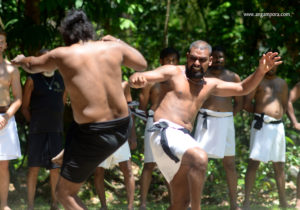 After years of insurgency, the foreign invaders managed to divide and conquer the island through trickery. This spelled fatal to the Sri Lankan martial art world, as its new foreign rulers, the appointed governor of Ceylon Robert Brownrigg banned and outlawed the practice of Angam. Extreme measures were taken that included imprisonment, persecution, and an order to shoot in the knees of any known practitioner of the art.
After years of insurgency, the foreign invaders managed to divide and conquer the island through trickery. This spelled fatal to the Sri Lankan martial art world, as its new foreign rulers, the appointed governor of Ceylon Robert Brownrigg banned and outlawed the practice of Angam. Extreme measures were taken that included imprisonment, persecution, and an order to shoot in the knees of any known practitioner of the art.
During the rule of Sri Lanka by the British, in the year 1818 it has been recorded on official documentation that the practice of the art was banned as part of their initiatives to dampen the efforts of the nation’s patriots to free the country from foreign dominance.
In the outset of such times, many (gurus) masters of the art, along with its avid practitioners went underground, and employed various methods of concealing the art in plain sight.
Due to the rich cultural heritage of the island nation Angam has an aesthetic value, in terms of rituals symbolism, and the mystique. Like all Martial Arts it had unarmed combat techniques, grips and locks as well as mastery in weaponry.
There are many varied views out there regarding this ancient art…. But what really is angam? According to the grand masters Angam has 2 different subject areas that can stand alone individually as vast bodies of study. Although some of these areas have been lost with the passing of time, but most of it has been preserved by true masters who exist to this day with their perseverance and true patronage of the art.
There are 2 aspects to this martial art that makes it fully integrated in to the cultural belief system of its people. These areas are namely
1. “Angampora”unarmed combat
2. “Illangampora” armed combat
Angampora (Unarmed Combat)
Unarmed Combat which is commonly known as “angampora” has its distinct meaning. “Angam” refers to the body while “Pora” refers to combat. So while angampora means the martial use of the limbs without the use of weapons, it is also divided in to three main categories.
1. Guti Haramba (Offensive & defensive techniques)
2. Gata Harammba (grips and locks)
3. Pora Haramba (ground fighting and wrestling techniques)
4. Maru Kala (vital point attacks)
1. PoraHarammba(offensive and defensive techniques)
This are covers the techniques relate to the offensive execution of different strikes and the defensive uses of a vast variety of blocks. In angam the artful execution of foot work is essential in mastering its powerful techniques.
In theory the master prompts his students to train their students to cultivate a strong metal and physical aptitude that requires them to train their proverbial eagle eye, for watch fullness, the Peacocks hearing, listen to the movements of the enemy, the leap of the monkey, to stay agile and supple, the walk of the tiger that refers to the readiness and alertness in ones movements, the grapple of a bear, the gait of the that refers to strength needed for ground fighting and executing neutralizing techniques.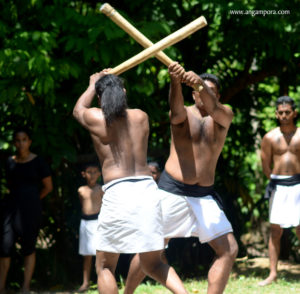
These techniques are taught in the form of movement sets that includes different combinations of strikes and block with the relevant foot work. Students are taught these sets of movements, from basic to more advanced varieties.
Gata Harammba (grips and locks)
Grips and lock in angam is an area that clearly set the art part from many others in the world. Over the years this areas has proven to be one of the most deadly and practical techniques to be taught in the “angam-maduwa” (dojo). It requires both strength and skill with the addition of extensive training in or to execute perfectly and effectively.
Different kinds of gripping and grappling techniques exists to counter different sorts of assaults. Those that are specifically used to neutralize an enemy who may strike with hand, foot, knife, sword… ect…
In reverse, the counters attack/releasing technique for a grip or a lock is also a separate area of study.
2. Guti Haramba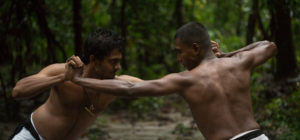
This area of angam is a study encompassing the practical application of the offensive and defensive techniques. This aspect is practiced by experienced students who are able to practice sparring without injuring ones sparring partner often under the strict supervision of the Guru.
Guti Haramba has its strong practical use sets of moves that has displayed in demonstrations… from the ancient kings court to the modern age.
Since ancient times Guti Haramba was practiced in pairs to perfect techniques for use in a realistic scenario. Modern day practitioners may engage in this with the use of sparring gloves and other protective equipment.
3. Pora Haramba
Pora Haramba is also a practical aspect of Angam that deals with the real world execution of ground fighting techniques. Although Angampora practitioners to not condone attacking and opponent who had fallen on the ground… it does contains techniques that can be used in the event of a ground fight.
This is also practiced in pairs and different grips locks and chokes are used. Pora haramba needs good skills in techniques and enormous physical stamina.
5. Maru Kala (vital point attacks)
Attacking specific pressure points of the body of an opponent’s is a deadly technique in angam. This is known as “Marukalawa”, can be called the “Art of Death”. But this at it not taught by the angam guru(master) to every student. Only the most trusted and experienced students are taught after extensive ceremonies offered to the god Rawana, and taking 7 oaths.
A knowledge of astrology is essential in order to use this art effectively. The art speaks of 107 major pressure point of the body, and 12 deadly ones.
There are many strikes that are executed with pressure points
• Attacking while griping pressure points
• Attacking points that cause sudden death
• Neutralizing a limb
• Attacking to induce blood vomiting
• Attacking mathematically (according to astrology) to caise death time after a specific cause to death.
• Striking to make enemy pass out•
• Attacking to make ill for an extend period of time.
• Striking to induce the creation of bodily excrement
Likewise, this kind of technique is unique to angam.
Along with the art of striking pressure points, it also related to its medical application for curative results.
When training, master and students alike take care to be very cautious. And in the case of an injury during practice, the medical applications are used to treat the injury. Experts in the art can treat ailments by applying the right amount of pressure to the right pressure points.
“Illangampora” Armed Combat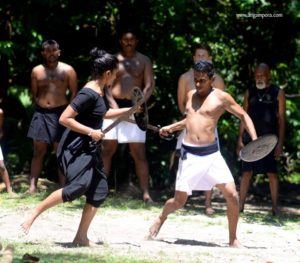
Ilnampora is another special part of Angam. This is known as the armed combat techniques of Angam. To be complete and competent Angam practitioner, the knowledge of Illngam is essential. Normally illangam is taught to a student after at least two years in to his training. Learning this requires a lot of discipline and dedication. Generally students are taught the techniques pertaining to all weapons; one can only “master” two or three weapons according to one’s physical prowess. Most of the weapons used for practicing are cleansed with specialized rituals. A student must be granted permission from the guru in order to learn particular weapon, and this is signified by performing a special ritual where the weapon is handed over to the student by the guru.
This art consists of 21 weapons. There are 4 main categories in this
1. Curved weapons
2. Circular weapons
3. Long weapons
4. Blunt weapons
Currently STIMA has reached international martial art arena with starting two international branches in Germany and Switzerland and STIMA also welcomes anyone who like to learn Angampora to start training with them. For more information regarding trainings and or demonstrations please contact them through their official web site www.angampora.com. If interested in more details please activate the attached video clip.


